-
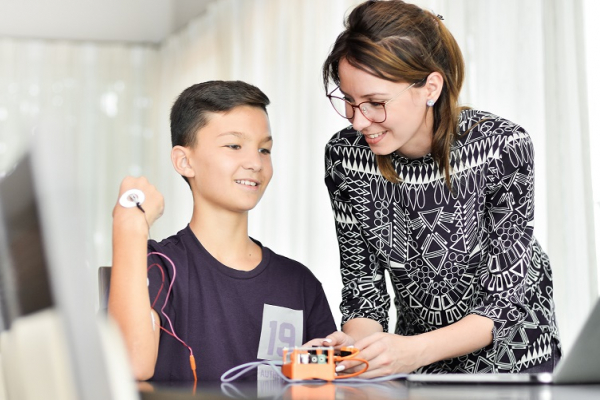 EducationFully remote, fully in-person, or somewhere in a sweet spot between the two. Those are the main safety concerns that are being laid right now in front of the decision makers, on behalf of students, parents, teachers and everyone around them, right at the kickoff of the new academic year. But whichever model prevails, it […]
EducationFully remote, fully in-person, or somewhere in a sweet spot between the two. Those are the main safety concerns that are being laid right now in front of the decision makers, on behalf of students, parents, teachers and everyone around them, right at the kickoff of the new academic year. But whichever model prevails, it […] -
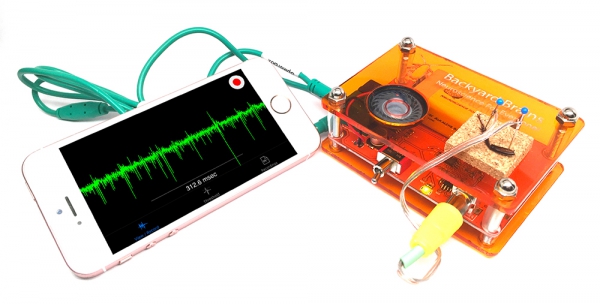 BizHow the SpikerBox Revolutionized K12 STEM Education… and just what is a SpikerBox? Backyard Brains exists today because of a once-lofty goal: To turn a $40,000+ rack of graduate-level electronics into a $100 kit that students could use in the classroom to perform real, hands-on neuroscience experiments. A decade later, we have developed four lines of products […]
BizHow the SpikerBox Revolutionized K12 STEM Education… and just what is a SpikerBox? Backyard Brains exists today because of a once-lofty goal: To turn a $40,000+ rack of graduate-level electronics into a $100 kit that students could use in the classroom to perform real, hands-on neuroscience experiments. A decade later, we have developed four lines of products […] -
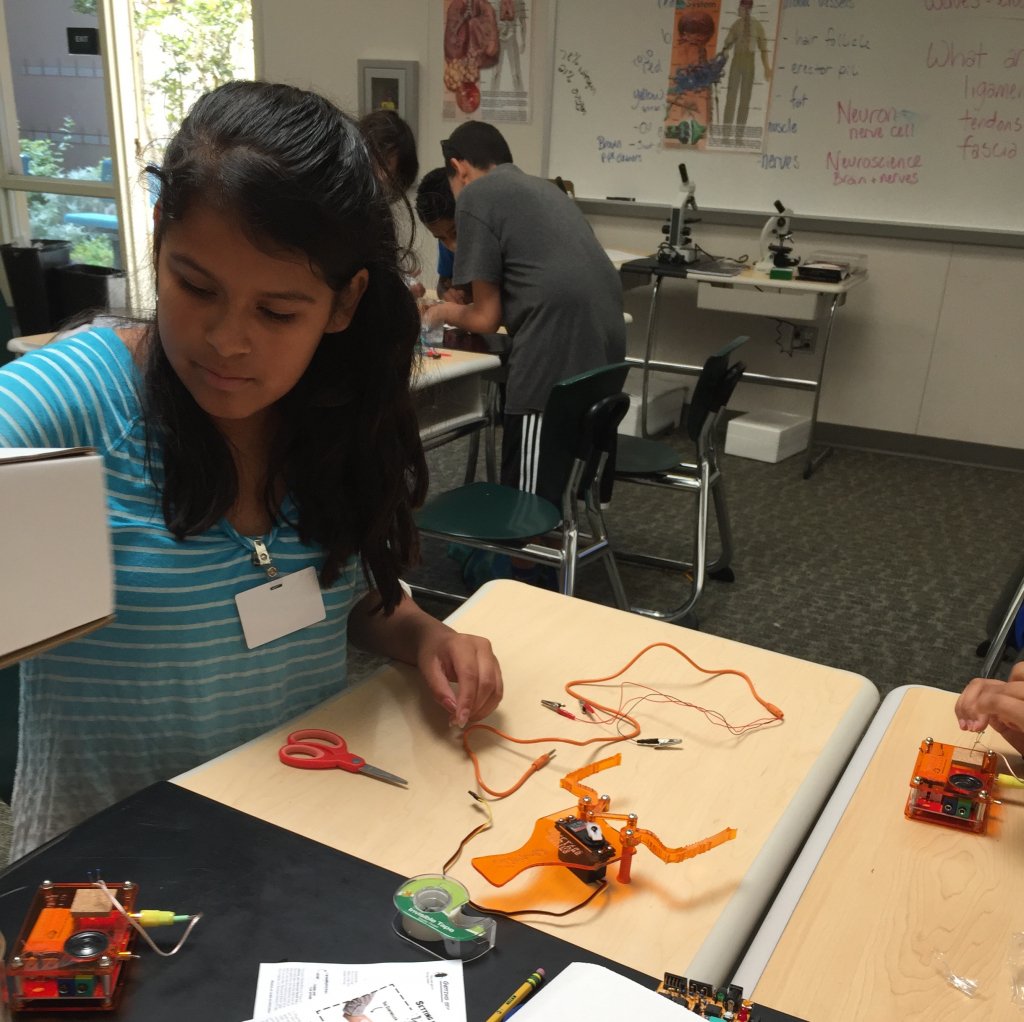 EducationA Middle School Teacher Testimonial! We met Deborah Antrim, a medical pathway and 8th-grade teacher in Rio school district, at CSTA this past year, and she told us all about the successes she had had with Backyard Brains gear in her classes and summer camps! We asked her to share some pictures and details about how […]
EducationA Middle School Teacher Testimonial! We met Deborah Antrim, a medical pathway and 8th-grade teacher in Rio school district, at CSTA this past year, and she told us all about the successes she had had with Backyard Brains gear in her classes and summer camps! We asked her to share some pictures and details about how […] -
 BizIn March 2019, Backyard Brains turned 10 years old! We’re officially double-digits! We have grown so much since our inception as a grad school side project, and we’d like to take some time to look back on the years that got us here. Thank you to our customers and our supporters for 10 great years. […]
BizIn March 2019, Backyard Brains turned 10 years old! We’re officially double-digits! We have grown so much since our inception as a grad school side project, and we’d like to take some time to look back on the years that got us here. Thank you to our customers and our supporters for 10 great years. […] -
 EducationIt’s early on a warm Ann Arbor morning and the office is buzzing with excitement! Our Summer 2017 research fellows are here! Today, our fellows are getting to know the staff and space at Backyard Brains, but more importantly, they’re planning, because for the next ten weeks they will be working on neuroscience and engineering […]
EducationIt’s early on a warm Ann Arbor morning and the office is buzzing with excitement! Our Summer 2017 research fellows are here! Today, our fellows are getting to know the staff and space at Backyard Brains, but more importantly, they’re planning, because for the next ten weeks they will be working on neuroscience and engineering […] -
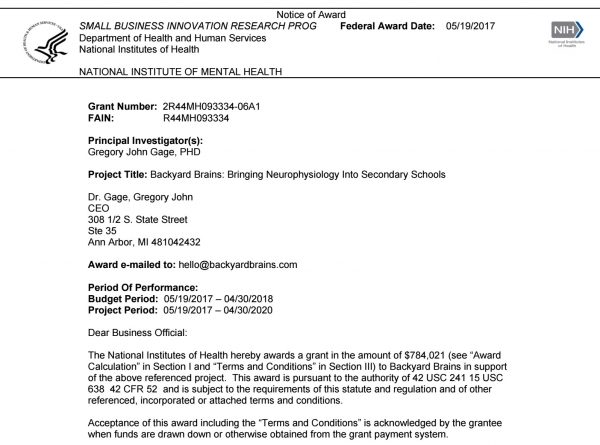 BizFour more years… of Science! It is an exciting day at the Backyard Brains office! After much revision and consideration, we have secured further NIH grant funding to continue our development of neuroscience education tools and materials! If you are unfamiliar, the National Institute of Health (NIH) is a federal agency that is responsible for performing and funding […]
BizFour more years… of Science! It is an exciting day at the Backyard Brains office! After much revision and consideration, we have secured further NIH grant funding to continue our development of neuroscience education tools and materials! If you are unfamiliar, the National Institute of Health (NIH) is a federal agency that is responsible for performing and funding […] -
 UncategorizedNeuroscience is making its way across the globe! Recently, The Harvard South Asia Institute selected 25 young students of technology to participate in a two-week long workshop, introducing them to the excitement and interdisciplinary nature of neuroscience and engineering in Bangalore, India. Course managers included our longtime Harvard colleagues and scientists Venkatesh Murthy and Laura Magnotti , and during two weeks […]
UncategorizedNeuroscience is making its way across the globe! Recently, The Harvard South Asia Institute selected 25 young students of technology to participate in a two-week long workshop, introducing them to the excitement and interdisciplinary nature of neuroscience and engineering in Bangalore, India. Course managers included our longtime Harvard colleagues and scientists Venkatesh Murthy and Laura Magnotti , and during two weeks […] -
 EducationDESCRIPTION Do you consistently think “breathe in, breathe out” or “left, right, left, right” when you’re walking? Unless you’re London Tipton (http://dai.ly/x31iwo0?start=346 to 6:02), you probably don’t. How is this possible? All humans have neural networks called central pattern generators (CPGs) that control rhythmic movements like breathing and walking. Unfortunately, it is nearly impossible to study […]
EducationDESCRIPTION Do you consistently think “breathe in, breathe out” or “left, right, left, right” when you’re walking? Unless you’re London Tipton (http://dai.ly/x31iwo0?start=346 to 6:02), you probably don’t. How is this possible? All humans have neural networks called central pattern generators (CPGs) that control rhythmic movements like breathing and walking. Unfortunately, it is nearly impossible to study […] -
![[Summer’16 Internship] The Dragonfly: Connecting the laser to the Spikerbox](https://cdn.hackaday.io/images/333271467267696195.png) EducationFrom previous neural recordings, I have data of the spikes of the TSDNs. However, I had yet to find a way to record the onset of the stimulus (turning on the laser) so that I could correlate it to the spikes. In order to both simultaneously record the event of the laser turning on and […]
EducationFrom previous neural recordings, I have data of the spikes of the TSDNs. However, I had yet to find a way to record the onset of the stimulus (turning on the laser) so that I could correlate it to the spikes. In order to both simultaneously record the event of the laser turning on and […] -
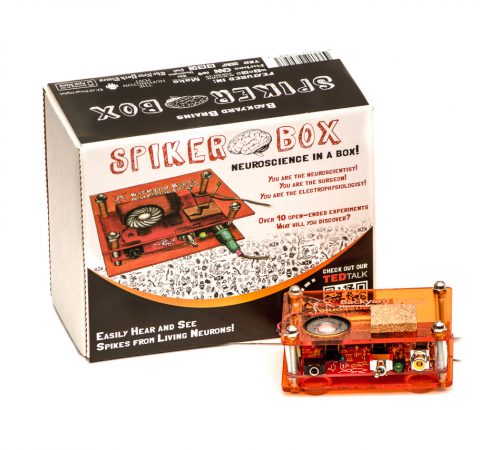 BizAs of this Monday, June 6 2016, we have made neuroscience history by selling our 10,000th Neuron Spikerbox! You can see the count for yourself at our open finance page. We would like to thank all of our customers so far for their support through the years. Without you, we couldn’t bring first time spikes to […]
BizAs of this Monday, June 6 2016, we have made neuroscience history by selling our 10,000th Neuron Spikerbox! You can see the count for yourself at our open finance page. We would like to thank all of our customers so far for their support through the years. Without you, we couldn’t bring first time spikes to […] -
 EducationTwo students from Stone Magnet Middle School in Florida, with the guidance of their teacher, Richard Regan, decided to make their science projects in neuroscience. We feel we’ve accomplished our core mission by just being able to write this statement: that today it is an option for students in middle school to make neuroscience experiments […]
EducationTwo students from Stone Magnet Middle School in Florida, with the guidance of their teacher, Richard Regan, decided to make their science projects in neuroscience. We feel we’ve accomplished our core mission by just being able to write this statement: that today it is an option for students in middle school to make neuroscience experiments […] -
 HardwareName: Katelyn Rowley School: University of Michigan (Go Blue!) Major: Biomedical Engineering Hobbies: Running (I’ve run a half marathon and I hope to run a full one someday!), journaling, trying new restaurants in Ann Arbor, being outdoors, finding new music to listen to (Florence and the Machines, Bon Iver, classic rock, you name it) What’s up interwebz? When I […]
HardwareName: Katelyn Rowley School: University of Michigan (Go Blue!) Major: Biomedical Engineering Hobbies: Running (I’ve run a half marathon and I hope to run a full one someday!), journaling, trying new restaurants in Ann Arbor, being outdoors, finding new music to listen to (Florence and the Machines, Bon Iver, classic rock, you name it) What’s up interwebz? When I […]